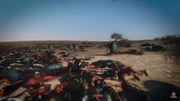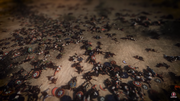The Battle of Yarmouk was a decisive battle fought between the armies of the Arab Rashidun Caliphate and the Byzantine Empire on 15-20 August 636 at he Yarmouk River in Syria amid the Muslim conquest of the Levant. The battle saw the destruction of a large Byzantine field army and the defeat of a major Byzantine counterattack into the Levant; as a result of the battle, the Levant was annexed to the Rashidun Caliphate.
Background[]
In 636 AD, the Byzantine emperor Heraclius assembled a large army of 140,000 Greek, Armenian, and Arab Christian troops at his stronghold of Antioch and deputized command to the generals Vahan, Qanateer, Dairjan, Jabalah ibn al-Aiham, and Gregory, as he was sick with edema and unable to personally lead his men. This army fanned out through the northern Levant, recapturing Damascus and Homs from the Arab Rashidun armies. However, the Arabs made a stand near the River Yarmouk in southern Syria, where Abu Ubaidah ibn al-Jarrah resolved to defeat the large Byzantine field army before the garrison of Caesarea could attack the Muslims from between Lake Tiberias and the Yarmouk River in the southwest.
Battle[]
The two armies met oun the Yarmouk plain, near the Jabal Druze mountains. The Romans built a fortified camp near Kafr-ul-Ma in the western part of the plain, while the central portion of the plain was unoccupied. Both armies engaged in extensive negotiations for weeks, but they ended in failure, and the battle was inevitable. The Caliph Umar's reinforcements, 5,000 Yemeni archers and 1,000 Arabian campaign veterans, joined the Rashiduns during the negotiation period. The Byzantines ultimately crossed an 11-mile-long ravine, the River Raqqad, at Kafr-ul-Ma, the only crossing. On 14 August, the Roman army formed up to the east and north of the River Alan, with Vahan and his corps commanders leading the army. Jabalah commanded the light Ghassanid cavalry, which was stretched across the plain as the vanguard. Qanatir commanded the left flank, Gregory commanded the right, and two central corps under Dairjan and Vahan commanded the central corps. While Abu Ubaidah was the overall commander by order of the Caliph, he allowed Khalid to give the orders. Khalid moved some of his light cavalry to the vanguard to observe the Romans, while his infantry were divided into corps of nine units each. Both armies had a southern flank secured by the River Yarmouk, while, to the north, the Arabs had the ability to flank the Byzantines through the desert.

The start of the battle
On 15 August, the battle began when the Roman light cavalry vanguard moved behind the main army to reinforce the left flank cavalry; the Arab vanguard also joined the main cavalry units. The champions of both sides then duelled for a few hours, and, after the screening forces pulled back, a third of the Roman infantry charged their counterparts as the archers on both sides exchanged volleys of arrows. After a few hours of fighting, both sides disengaged and returned to their camps. At night, a few Roman light cavalry units were forced back by the Arab cavalry. The Romans then formed up in the darkness, hoping to attack the Muslims as early as possible and prevent them from getting into formation. The whole Roman army attacked before dawn, anticipating that the Muslims would be praying at that time. Unfortunately for the attackers, the Arab light cavalry once again alerted their comrades of the impending attack, and the Arabs prepared for the attack. The Romans launched a passive attack in the middle as the flanks launched strong attacks, moving fresh troops to the front and pushing the Arab right back after three charges. The Arab right wing cavalry launched a counterattack, tiring out the Byzantines and allowing the Arab infantry to retreat. The Arab cavalry then retreated as well, and the wives of the retreating warriors shamed them into returning to the battle. The Arab right flank reformed and counterattacked. Meanwhile, the Roman right was even more successful due to the presence of their elite infantry in their ranks. The second Roman attack drove the Muslim left back, forcing them back towards the flank. However, the Muslim cavalry attempted to stem the Roman advance in a counterattack before retreating with the infantry. Their wives urged them to return to the battle and even threw stones at their husbands, and the heavily-armored Romans were too slow to prevent the Arabs from receiving reinforcements. The Byzantines failed to pour in troops through the Arab gaps or outflank them, as they feared Arab cavalry attacks or flanking moves. Khalid then took command of the cavalry in the center, attacking the Byzantine left from the flank and forcing them to retreat to their original positions. Khalid then swung his cavalry to help the Arab left, exploiting the gap between the Byzantine right and center and flanking the Roman right. The Romans retreated, albeit with less casualties than the left. The cavalry then charged into the Roman center-right, killing its commander. Seeing that their flanks were retreating, the Byzantine center retreated to its starting position. Both sides suffered similar losses in the battle.
On the next day, the Romans again charged, targeting the Muslim right and center-right. The Roman numbers began to overpower the Arabs, pushing them back to the camp. Amr ibn al-As' corps then stabilized, but the Byzantine cavalry repelled an Arab cavalry counterattack. Khalid again came to the rescue once he saw that the Roman left was being passive, moving the reserve cavalry to charge the Roman flank. The Byzantine commander attempted to move more troops from the second flank to the front, but the Romans were pushed back at dusk, disengaging along with the rest of the Roman army. In the first three days, the Romans lost more troops than the Arabs, but they still outnumbered their foe. Khalid had to worry about the loss of many of his archers and the right flank.

The Roman withdrawal
The next day, the Byzantines attacked the right half of the Rashidun army with the goal of encircling each corps separately, and then doing the same to the Muslim left. The Muslim right was forced back, and the Armenian center-left also turned the Arab line. The Christian Arab light cavalry reserve was then commanded to charge into the gap between the Muslim left and right, inflicting heavy losses. Khalid ordered the left and center to advance and tie up the Byzantine right before dividing his cavalry into halves to attack the Armenians from the side and rear as he himself attacked the Christian Arabs. Eventually, the Muslims started gaining the upper hand, and the Armenians retreated in relative order, while the Christian Arabs lost many hundreds in the retreat. The Muslim left initially gained the upper hand over the Roman right before being pushed back, and the Roman skirmishers had the upper hand over the fewer Arab archers. The Arabs were forced to pull back, followed by the Romans. The Muslim cavalry then counterattacked, charging the right side of the Romans. The Muslim withdrawal stopped at the camp, but they were still chased by the Romans. The Muslim women joined their brethren in the fight, and the Romans were either pushed back or disengaged on their own. Both sides were extremely tired and battered, and the Romans attempted to negotiate, although the Arabs refused.

The dead at Yarmouk
Khalid then consolidated his horsemen on the right flank, but he sent one cavalry unit into the desert. On 20 August, the sixth day of the battle, both sides engaged again, and he had his cavalry outflank and attack the Roman left. Roman cavalry blocked the Arab advance, and he sent the rest of his horsemen to attack the Roman cavalry from the side and rear, crushing them. The Muslim cavalry then attacked the Muslim center-left from the side and rear, and the Romans attempted a mounted counterattack. Before they could form up, Khalid slammed into them and routed them. Once the Roman cavalry was defeated, he charged the rear of the Armenian formation, and they collapsed. The Roman center-right infantry fled to the southwest fled across the River Alan, and the 500-strong Arab unit in the desert blocked off their crossing at Kafr-ul-Ma. The Romans formed a new defensive line, but they were attacked from all sides, and many thousands were slaughtered. Half of the Roman army lay dead on the River Yarmuk, and the Muslims lost less than a fifth of their number.
